If you own an antique kitchen sink in your house I seriously hope you know how lucky you are. This type of sink is something you can see in traditional and rustic farmhouses. Something about them makes every kitchen looks more appealing.
Vintage sinks are robust, large, and designed with a single bowl or double bowl (also called double basin). For centuries they were the centerpiece of every kitchen, this is why they always dominated in size, to ensure that washing would not be a burdensome process.
Even though today most households use dishwashing machines, it is still a great idea to invest in a vintage kitchen sink that will make your cleaning, food prepping, and dishwashing more convenient.
Table of Contents
What Materials Were Used For Crafting Antique Kitchen Sinks?
Today vintage-style kitchen sinks are a popular theme. What I love about them is how ergonomic and neutral they are. Aprons will perfectly fit with rustic as well as modern style kitchen design. They are even compatible with garbage disposals!
As I said, massive kitchen sinks were the center of every kitchen back in the day. They were large enough, so a person could comfortably wash multiple loads of dishes, and wash and prepare large chunks of meats.
Crafting material largely varied depending on the era. This is when materials like porcelain and enamel were used for the first time.
However, the list of materials that were used over the years is way longer. Some farmhouses even had kitchen sinks made out of concrete. For instance, this is a very popular trend nowadays. Material that is used for making antique kitchen sinks:
- Iron and cast Iron
- Porcelain and enamel
- Ceramic
- Fireclay
- Concrete
- Copper
- Nickle
- Brass
- Stainless steel
Types of antique kitchen sinks
Mainly old large kitchen sinks were called farmhouse sinks. However, a vintage sink could sport a different style depending on its purpose.
Dry sinks
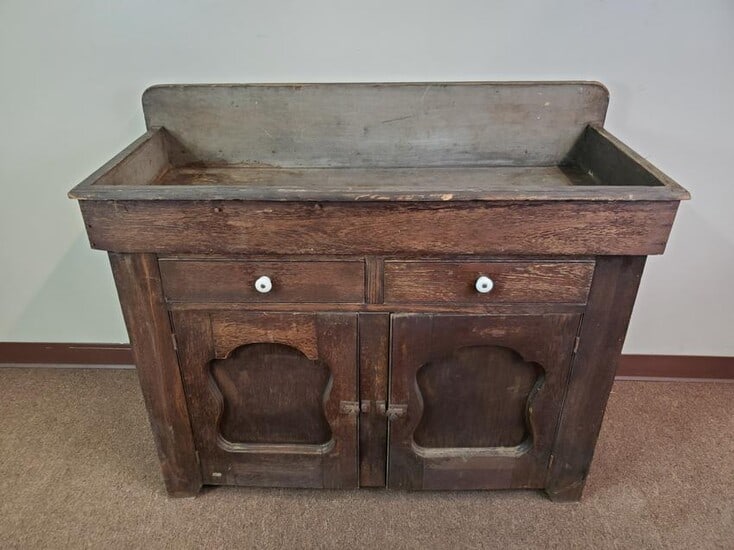
Before the mid-20s when the first plumbing system was built in the sinks, people mostly used “dry sinks”. These were freestanding sinks made from wood, with single or double basins, and a pitcher.
Considering they couldn’t be drained, people usually needed to lift them and dump the water outside. These sinks were used in the kitchen, as well in the bathroom.
Wet sinks
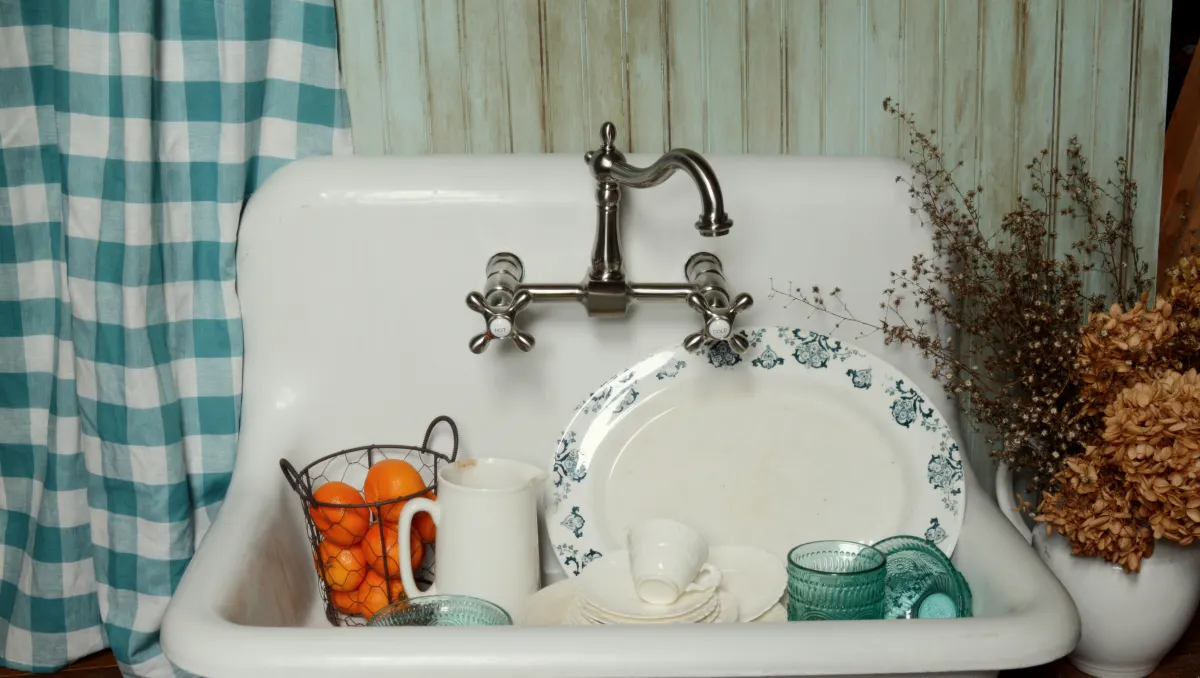
But what we know as classical farmhouse kitchen sinks were mass-produced in the early 20th century. These first “wet sinks” were rather large, often rectangular-shaped, with double basins, and built-in the massive sturdy cabinets.
The farmhouse sink was a kitchen appliance on its own since it could accommodate massive amounts of dishes and most importantly food. Their purpose was not only for washing dirty dishes.
Customized sinks
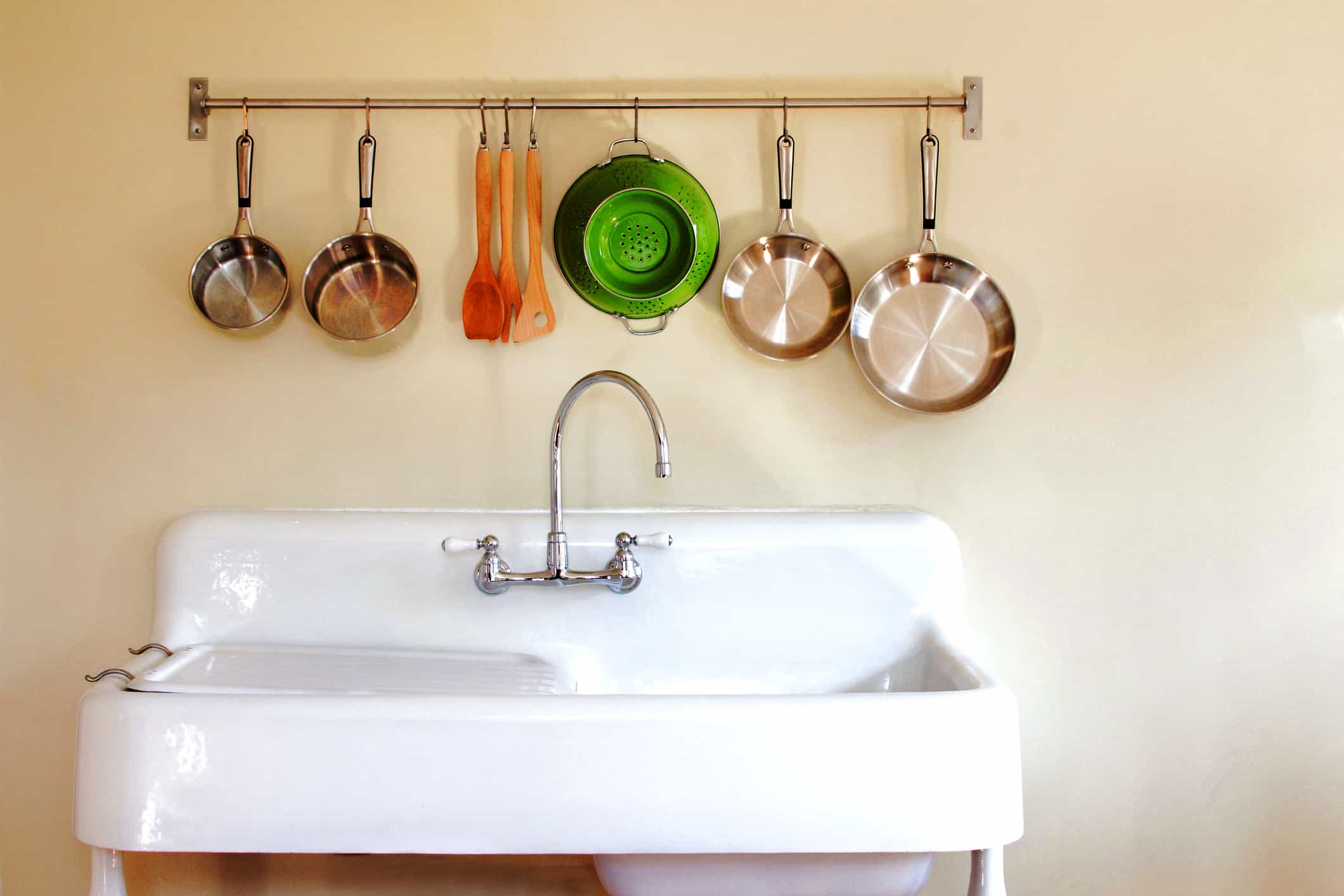
Since refrigerators weren’t so common then, food was mainly canned and preserved for future consumption, and the preparation process always began in the sink. Most of these early sinks were customized to fit the owner’s needs. These were the most common modifications:
- Customized height – Considering how much time a person would spend leaning over the kitchen sinks, most aprons were crafted according to the height of the owner.
- Drop-in style sinks – These sinks had most of the covetable countertop space removed in case they can’t fit the whole construction.
- Drainboards – As the name says, these were boards or racks installed on the sides of sink basins so people could leave their wet dishes to drain.
- Single or double basin – Depending on your needs you could choose either a single basin or two basins.
- Troughs – Trough sinks are large sinks with one long basin and multiple faucets. Usually, they were used for preparing and preserving meats.
- Faucet soap dish – Metal soap dishes were also built-in vintage kitchen sinks, mainly on top of a sink’s faucets
Antique Kitchen Sinks Value Guide
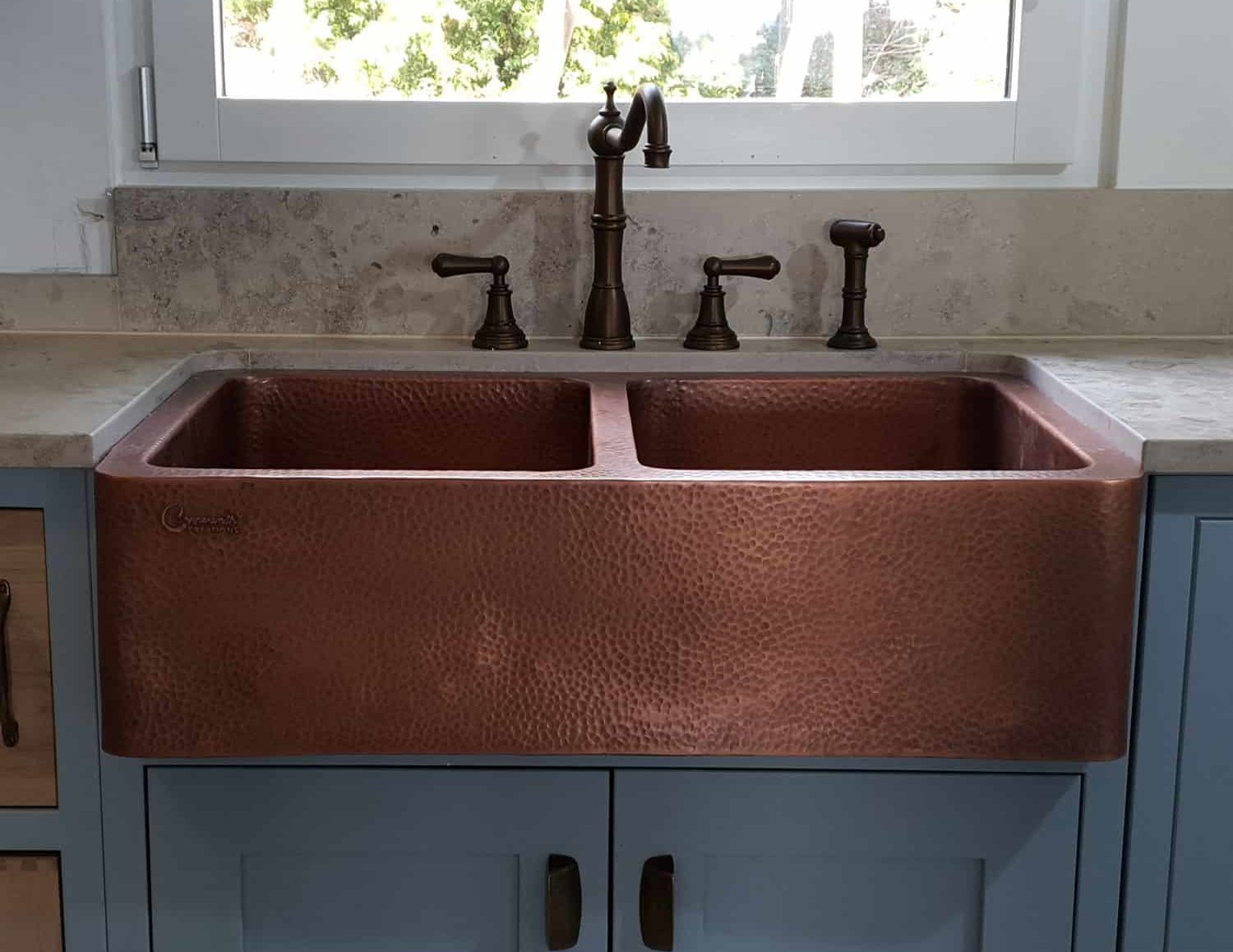
You’ve got a lot of enticing options when looking for an antique kitchen sink. Some models are cheap and cute, while others are expensive and gorgeous, it depends on factors like:
- Size – Vintage kitchen sinks are available in a vast variety of sizes. From small ones to large ones that are almost the size of a regular tub. The smaller widths are somewhere around 18” and the largest ones are around 50”. On the other hand, depth goes from 6” to about 12”, which means that with greater capacity the price rises as well.
- Model – You can choose single, double, and triple bowl kitchen sinks. The more bowls it has, the larger the sink is, which in the end raises the final price.
- Type – Don’t be confused type and model aren’t the same things. Type means is it top mount (drop-in with self-rimming) or under-mount (farmhouse and apron).
- Condition – Naturally, sinks in excellent condition will be more expensive than those that need repairing.
- Material – Some types of material are sturdier, heavier, and more valuable than others. Vintage sinks made from high-quality or rare material are exceptionally valuable and expensive.
How To Refurbish An Antique Kitchen Sink?
Antique kitchen sinks can be very valuable collectibles if they are maintained in a good condition, or if they’ve been refurbished. As long as you don’t make any significant alternations they will keep their value and still be useful in the kitchen since collectors buy them to actually use them.
So as you can see it pays off to spend some time and money on the restoration of your vintage apron. If you are not so good with restoration and polishing the best thing you can do is hire a professional to do it instead of you.
However, if you are feeling adventurous and you would like to try to refurbish and revitalize your vintage sink while staying on the budget, you’ll love this. Behold, a handy step-by-step guide that will teach you all you need to know.
Step 1 – Removing the rust and paint
Most vintage sinks need to be rubbed and scrubbed with a rough wire brush to remove the remains of old flaky paint and rust. Make sure you really put a lot of pressure on the surface to make it smoother and remove all the small and large chips, so the new coat of paint will stick better.
Step 2 – Wash down all debris and dust
Removing paint and rust is a messy job, and the final result is a sink full of debris and dust that must be thoroughly removed. I didn’t mention but restoration is a job you should do in the backyard.
Take out the garden hose and use high-pressure to spray down all the debris and dust and let it air dry for a couple of hours or even a whole day if you’re dealing with cast iron or iron sinks.
Step 3 – Apply the protective enamel paint on the outside
Once your vintage sink is completely dry it is time to apply the protective coat, that will keep the rust away. You can use products like Rust-oleum protective enamel paint in matte, gloss, or semi-gloss white, depending on what you prefer.
This paint is designed to protect the sinks and bathtubs from rust. Apply one layer on the outside of the sink and make sure you let it dry overnight.
Step 4 – Cleaning the insides of the sink
Most vintage sinks have a lot of stains, cracks, and scratches on the inside that is hard to handle. In case you are dealing with a cast iron sink, this process is less painful considering this material is nonporous, but if you have a porcelain sink this is where you need to be careful.
If you were lucky, and your sink is not too damaged on the inside, you can apply a paste made out of water and Borax and leave it overnight. You can also try white vinegar and baking soda.
After this treatment, the stains should be gone or at least visibly paler. In case this does not work you should try using some product that is good for removing limescale and rust from bathtubs and sinks. But be careful these can damage the antique furnace.
Step 5 – Applying topcoat
In case you are dealing with a porcelain sink, before this step, you should reglaze your sink with epoxy primer in at least two layers to give it that new porcelain look. After these layers dry off apply the acrylic topcoat that will protect the paint.
This step will take at least two days. You need to apply the topcoat in three thin layers, and always move the brush in the same direction! Let each layer dry for at least 12 hours before you apply the next one.
It is recommended to not use your refurnished sink for at least 5 days after the restoration to let everything set down properly.
It is important to keep the authentic look!
Conclusion
I forgot to mention that in design terms antique kitchen sinks are the ones that originate from the period before the 1950s. You’ll recognize them by their characteristic strong old-fashioned style and retro charm paired with high-quality materials.
If you recently redecorated your kitchen and got yourself a lot of vintage kitchen items and among them an antique kitchen sink we would like to hear more about it. Share your experience with us, and let us know how and where you got it, and how you revitalized it.
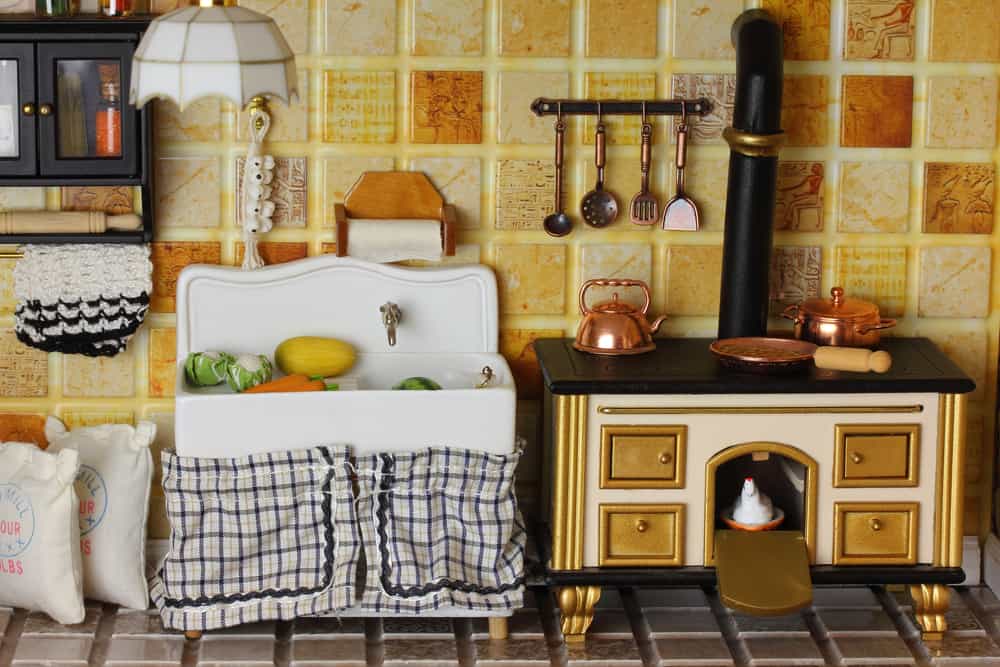
Hi, I have a butler sink that on the under side has markings:-
H MULLINDER
And hand enscribed a date 9/9/33
And 25x
I’ve tried finding out about it and have found nothing. I presume it was made in 1933 but could also be 1833?
Any ideas would be very much appreciated. Thanks in advance
Hello,
My name is Justin. I recently acquired a 1923 cast iron, I think ceramic coated, double basin farmhouse sink. The inscriptions are as follows:
No.1 Made in United States if America
Standard Sanitary Mfg. Co. Pittsburg .
I can also see a date on the drain. March 20, 1923. I think I have something here. Can you please let me know some information.
Thank You!
Hello, this is Justin again. I haven’t heard anything back from you. Is there a problem with replying to my message? My # is (845) 742-7335 if that is the case. Thank you.
I’m sorry I meant Pittsburgh.
Hello,
My name is Justin. I. Recently acquired a 1923 cast iron, I think ceramic coated farmhouse kitchen sink. The inscription reads as follows:
No. 1 Made In United States of America Standard Sanitary Mfg. Co. Pittsburgh
And on the drain Paid March 20 1923.
I think I have something here. Thank you for any information!